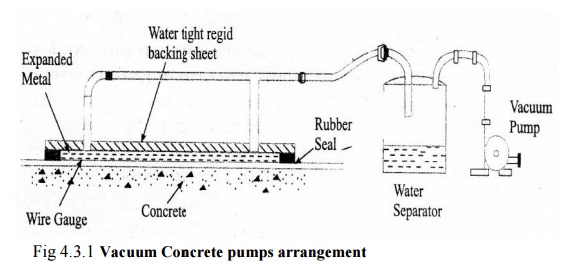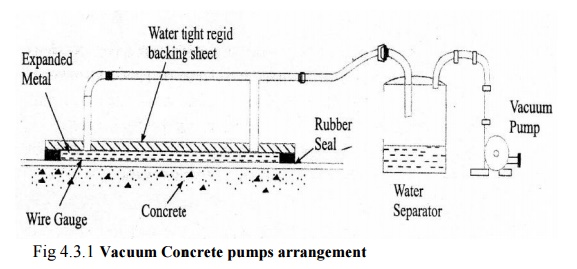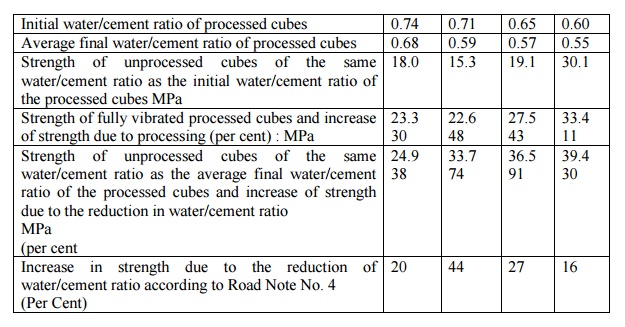Chapter: Civil : Repair and Rehabilitation of Structures : Techniques for Repair and Demolition
Vacuum Concrete

Vacuum Concrete
It has been amply brought out in
the earlier discussion that high water/cement ratio as harmful to the overall
quality of concrete. Whereas low water/cement ratio does not give enough
workability for concrete to be compacted hundred per cent. Generally, higher
workability and higher strength or very low workability and higher strength do
not go hand in hand. Vacuum process of concreting enables to meet this
conflicting demand. This process helps a high workable concrete to get high
strength.
In this process, excess water used for higher
workability, not required for hydration, and harmful in many ways to the
hardened concrete is withdrawn by means of vacuum pump, subsequent to the
placing of the concrete. The process when properly applied, produces concrete
of quality. It also permits removal of formwork at an early age to be used in
other repetitive work.

The equipment is shown inn Figure
4.3.1. It essentially consists of a vacuu m pump, water separator and filtering
mat. The fi ltering consists of a backing piece with a rubber seal all round
the periphery. A sheet of expande d metal and then a sheet of wire gauge also
form s part of the filtering mat. The top of the suctio n mat is connected to
the vacuum pump. When the vacuum pump operates, suction is created within the
boundary of the suction mat and the excess of water is sucked from the concrete
through the fine wire gauge or muslin cloth. At least on e face of the concrete
caused by loss of water must be vibrated.
The vacuum processing c an be
carried out either form the top surface or from the side surface. There will be
only nominal difference in the efficiency of top pr ocessing or side
processing. It has been seen that t he size of the mat should not be less than
90 cm x 60 cm. smaller mat was not found to be effective.
Rate of Extraction of Water
The rate of extraction of w ater
is dependent upon the workability of mix , maximum size of aggregate,
proportion of fines and aggregate cement ratio. In general, the f ollowing
general tendencies are observed:
(a) The
amount of water whic h may be withdrawn is governed by the initial workability
or the amount of free water. A great reduction in the water/cement ratio can,
therefore, be obtained with higher initial water/cement ratio.
(b) If the
initial water / cement ratio is kept the same the amount of water which can be
extracted is increased by i ncreasing the maximum aggregate size or reducing
the amount of fines in the mix.
(c) Although
the depression of the water/cement ratio is less, the lower the initial
water/cement ratio, the final water / cement ratio is also less, the lower the
initial value.
The reduction in the water / cement ratio is very slightly
less with mixes l eaner than 6 to 1, but little advantage is gained with mixes
richer than this
(e) The
greater the depth of concrete processed the smaller is the depression of the
average water/cement ratio.
(f) The
ability of the concrete to stand up immediately after processing is improved if
a fair amount of fine material is present, if the aggregate size is restricted
to 19 mm and if a continuous grading is employed.
(g) Little
advantage is gained by prolonging the period of treatment beyond 15 to 20
minutes and a period of 30 minutes is the maximum that should be used.
It is found that there is a
general tendency for the mix to be richer in cement near the processing face.
This may be due to the fact that along with water, some cement gets sucked and
deposited near the surface. It is also found that the water/cement ratio near
the surface will be lower in value, anything from 0.16 to 0.13, than the
original water /cement ratio. Because of the above reasons the vacuum processed
concrete will not be of uniform strength.
The simultaneous vibrations or
the subsequent vibrations will reduce this shortcoming to some extent and also
increase the strength of the concrete. If vibration is not done, the continuous
capillary channels may not get disturbed and the strength would not be improved
in relation to decreased water/cement ratio. Table 12.15 shows the comparisons
of strength of processed and unprocessed cubes.
Table. 4.3.1 Comparison of
Strength of Processed and unprocessed cubes having the same water/cement ratio

Related Topics